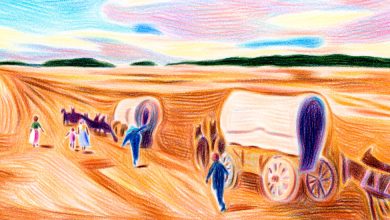Silky Ballet Solos and Irresistible Tapping Toes Close Fall for Dance

When Fall for Dance checks all the boxes and puts on a satisfying show, you can’t help but feel a sense of euphoria about the art form and its myriad possibilities. But it’s rare. The New York City Center festival, popular for its eclectic programs and inexpensive tickets, can also make you feel a little sick to your stomach — it’s like being at a buffet and making the terrible decision to gorge on sushi, pizza and every last dessert on the menu.
On Saturday night, I didn’t feel queasy because of two dances, one by the ballet choreographer Alexei Ratmansky and the other by the tap artist Ayodele Casel. Ratmansky’s “Fandango,” presented with the Vail Dance Festival, placed Roman Mejia, the recently named New York City Ballet soloist, in one of his most dazzling performances to date.
This was the first time it was performed by a man, but it’s not exactly a solo: In “Fandango,” Mejia was joined by Alberta Khoury on guitar and Dario Natarelli on percussion, along with the string quartet Brooklyn Rider. Originally created for Wendy Whelan in 2010, it was later danced by Sara Mearns; “Fandango” supplies Mejia, who is always an outgoing dancer, with a lavish opportunity to explore musicality and nuance.
In this Spanish-influenced dance to music by Luigi Boccherini, Mejia is almost casual as his silky arms caress the air; his fingers swirl like cream. Everything is etched into the space, including built-in moments with the musicians — at one point he is handed a tambourine, only to have it taken away — but it all feels fresh, spontaneous and utterly unmannered. “Fandango,” for all of its rich details and in-between flourishes, is a seven-minute tour de force that demands explosive attack and abandon and impeccable technique.
In the end, Mejia, lost in a flurry of grand traveling jumps and propulsive pirouettes, winds up on the floor — both wiping out and wiped out. It’s a thrill. He should dance this at City Ballet and share it with Mearns and others.
Casel, for whom music and dance also go hand in hand, wrapped up the evening with the captivating premiere, “Where We Dwell,” a City Center commission, to music by Crystal Monee Hall, a singer and songwriter with a rich, creamy voice, and direction and staging by Torya Beard.
Featuring eight exceptional tap dancers, including Casel, the work, which transforms the stage into a kaleidoscope of vibrant dancing bodies with intricate footwork and ever-changing patterns, is clear about social justice, yet also subtle. In one number, Hall, also credited with music direction, reimagines “This Land Is Your Land” so that by the time she’s finished singing it to five dancers, it’s clear who the land should belong to: everyone.
Casel, soulful and penetrating, reveals an even deeper layer of artistry when she pulls up a stool next to Hall and listens to her sing the original song, “Work Me Over”; even while seated her feet can’t stop. She grazes the floor with the tips of her shoes and finally, as if the music has entered her body, grabs a mike and makes her own music, scatting as her rapid fire steps stitch together the lightest and brightest of sounds. She’s a dance poet. Her language is born from her feet.
That program’s centerpiece, “Bloom,” another Vail coproduction, is the choreographer Justin Peck’s take on the classical pas de deux. Featuring Tiler Peck (a City Ballet principal and no relation to Justin) and American Ballet Theater’s Herman Cornejo, “Bloom” looks to George Balanchine’s glorious “Tchaikovsky Pas de Deux” for inspiration.
Throughout, there are references to not only the music (a collaboration with the composer Caroline Shaw) and the dance but also in the palette and feel of the costumes by Reid Bartelme and Harriet Jung. In “Bloom,” the emphasis is more on energy than arc as the dancers make sweet nods that reference the past. But beyond their star power and technique, it isn’t always clear just why they’re dancing together. “Bloom” never really blossoms; it’s an accumulation of steps — animated and bright but with little heart.
For once, on the fourth program seen Friday, the best piece garnered the most applause: Lar Lubovitch’s “Each in His Own Time.” Adrian Danchig-Waring and Joseph Gordon, two principal dancers at City Ballet, began separated in spotlights at first, not dancing but listening to the pianist, Susan Walters, as she played selections from Brahms’s Eight Piano Pieces (Op. 76).
As with “Fandango,” the music was as much a part of the piece as the dancing, giving this City Center commission the feeling of a trio. Walters’s sparkling performance propelled the dancers into motion; they curled their arms and linked hands, almost making a chain with only two bodies. Their dancing — florid, continuous, unsentimental — grew larger as they explored the stage with light jumps and darting, tight spins. But this intimate, luminous world remained contained; the performers didn’t look out, they looked in, as if dancing only for each other.
Not everything was as sophisticated. In “Mapping Out a Sky” a New York premiere for the Philadelphia company BalletX, the choreographer Matthew Neenan took an architectural approach to the structure, delivering movement that flickered between a formal investigation of time and space and something altogether more jazzy — cloyingly so. But the dancers of BalletX were appealing. One of the most charming moments of the evening came when two of them — Ashley Simpson and Blake Krapels — made a surprise cameo in the spirited, swinging “Meet Ella,” a last-minute addition by Caleb Teicher and Nathan Bugh. Walking onto the stage in their “Mapping” costumes, they found themselves lost in someone else’s dance, a delightful joke for the way they played into it.
On the previous evening, “Meet Ella” had replaced a work by Lil Buck, who was prevented from performing because of an issue regarding Covid-19 protocols. On Friday, Buck made it onstage in “38109,” another presentation with Vail. Named after his Memphis ZIP Code — where he first learned his chosen movement language, the street dance of jookin — Buck unveiled a personal piece with music, again by Shaw, and his own text.
In near darkness, he first moved his arms, which braided together at his head, before making his way to the middle of the stage to a pair of pristine sneakers. After slipping them on, he rose with a spin and nimbly balanced on his toes. Undulating his arms like ribbons as his feet carried him across the stage, Buck showed what a spectacular dancer he is. But as for the work itself? Opaque and not much longer than a music video, it fizzled out before it really got started.
But what also left me hanging was the realization that over the course of two nights and seven works, only one was created by a female choreographer. And what if Casel wasn’t as brilliant an artist as she is? Would she have made it at all? This counting routine — keeping track of the male-female ratio of choreographers — may be getting old, but it’s clear that we have a long way to go before we’re done.





